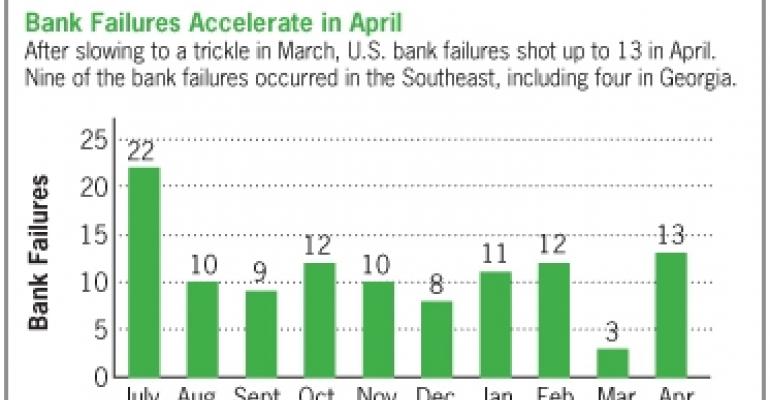The number of U.S. bank failures in April jumped to 13, the highest monthly total since July 2010, according to New York-based commercial mortgage information and analytics firm Trepp LLC. While the reasons for failure were varied, commercial real estate loans represented the largest source of nonperforming loans.
Nine of the bank failures occurred in the Southeast, including four in Georgia, two each in Florida and Alabama, and one in Mississippi. Three of the failures occurred in the Midwest — one each in Illinois, Michigan and Minnesota — and one in Nevada in the West.

Georgia leads the country in bank failures with 10 year-to-date, and 60 since the cycle started in 2007 with the closure of NetBank in Alpharetta. Florida and Illinois each have had four failed banks year-to-date. Florida has had 47 closures since the cycle began, while Illinois has had 41.
Among the 13 failed banks in April, commercial real estate loans accounted for $599 million of the $759 million in nonperforming loans, or 79%. Construction and land loans made up $346 million, or 46% of the nonperforming pool. Commercial mortgages comprised $253 million (33%) of nonperforming loans.
The residential real estate loan category was second, with $112 million in nonperforming loans, or 15% of the total nonperforming balance.
The remainder was comprised of commercial and industrial loans ($31.3 million, 4% of the nonperforming total) and consumer and other loans ($17.1 million, 2% of the total).
All but one of the bank failures in April involved loss-sharing agreements executed by the Federal Deposit Insurance Corp. (FDIC), with 67% of the assets acquired being covered by loss-sharing agreements.
In a loss-sharing agreement, the FDIC agrees to absorb a portion of the losses resulting from resolution of the loan portfolio. In the past, the FDIC has agreed to absorb 80% of the losses to a stated threshold and 95% of losses thereafter. The agreement minimizes the downside risk for a buyer of a troubled loan portfolio.
There had been a growing sense that acquirers were becoming less enthused about the loss-sharing agreements, according to Trepp, and more willing to bet on diminishing losses supported by a strengthening economy.
“The fact that loss-sharing was involved in nearly all the deals in April, and that it covered approximately two-thirds of the assets acquired, would seem to indicate that failed bank buyers are still treading cautiously,” concluded Trepp in its synopsis.

